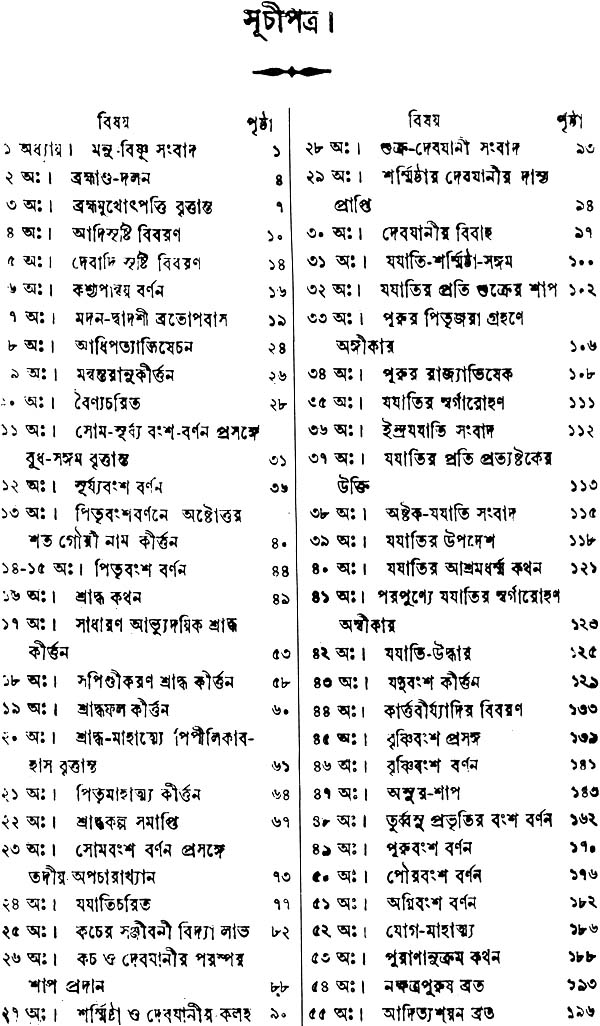
Matsya Purana English Pdf
From the Jacket: The Matsya Purana earns its title from the fish incarnation of Visnu, the other nine being Kurma, Varaha, Narasimha, Vamana, Bhargava Parasurama, Rama, Krsna, Buddha and Kalki. The Matsya Purana is not all based totally on the life story of Matsya, but it deals with various other subjects, though in some of the chapters Matsya himself is the speaker. Matsya Purana contains 291 chapters in total. First among all it describes the dialogues between Manu and the Lord, known as Manusamvada and deals with the following subjects in successive order, viz- the history of Brahmanda, the Sariraka Samkhya as explained by Brahma, the origin of the Devas and Asuras, as well as Maruts, the observance of Madanadvadasi vrata, the ways of the worship of the Lokapalas, the description of the Manvantaras, the history of king Vena, the birth of the Sun and Vaivasvata and the meeting with Budha. Then it deals with the families of the manes, the times of performing Sraddha, Pitrtirtha Pravasa, the birth of the moon, the history of Yavati, the glory of Svamikartika, the history of the Vrsni and Yadava houses. Then it describes various ordinances, glory of various tirthas and rivers, the movement of Sun and Moon and their relative positions, the churning of the ocean, worship of the Devas, the characteristics of palaces, pandals and housebuilding, the forms of the temples and pandals, the history of Puru dynasty, the narration of the coming sovereigns, the description of the sixteen gifts such as Tuladana, etc., the names of the Kalpas etc. The present edition of Matsya Purana is a complete book in 2 volumes that includes Sanskrit text, English translation with Notes, an exhaustive Introduction and complete Index of Verses.
We hope that this book will be very useful not only for the general readers who have interest in ancient Indian literatures, but also for the scholars.
• The Matsya Purana Introduction There are eighteen major Puranas or mahapuranas, the word 'maha', meaning great. There are also several other minor Puranas or upapuranas, the word 'upa' signifying minor. Amongst the eighteen mahapuranas, the Matsya Purana is number sixteen. The Puranas themselves describes the five characteristics (pancha lakshana) that a text must satisfy before being classified as a mahapurana. That is, any such text must dscribe five different subjects. Sivayya serial gemini code.
That the Vayu, Vishnu, Bhagavata, and Matsya Puranas, in which these. There is another classification of the Puranas alluded to in the Matsya Purana,.
These are the original creation of the universe (sarga), the periodical process of destruction and re-creation (pratisaryga), the various eras (manvantara), the histories of the solar dynasty (surya vamsha), and lunar dynasty (chandra vamsha) and royal genealogies (vamshanucharita). The Matysa Purana describe these five different subjects. Traditionally, the Ramayana is believed to have been composed by the sage Valmiki and the Mahabharata by the sage Vedavyasa.
Vedavyasa was the son of Satyavati and the sage Parashara. His real name was Krishna Dvaipayana.

The word 'Krishna' means dark and he came to acquire the name because he was dark in complexion. The word dvipa means island and the sage acquired the name of Dvaipayana as he was born on an island.
The Mahabharata has one lakh shlokas or couplets. After composing the Mahabharata, Vedavyasa composed the eighteen mahapuranas. These texts have four lakh shlokas between them, although they are not equal in length. The Matsya Purana is a medium-length Purana, and consists of fifteen thousand couplets. The longest Purana, the Skanda Purana, has eighty-one • thousand. Sattam oru iruttarai mp4 songs download mp3. And the shortest Purana, the Markandeya Purana, has only nine thousand.
The fourteen thousand shlokas of the Maysya Purana are divided into two hundred and ninety-one chapters (adhyaya). The eighteen Mahapuranas are sometimes divided into three groups, with six Puranas in each group. There are 33 million administrative demigods mentioned in the Vedas. But the primary gods are Brahma, Vishnu and Shiva. Brahma is regarded as the creator, Vishnu as the maintainer, and Shiva the destroyer.